Exploring the Key Causes of Vision Impairment
Worldwide, over 2.2 billion individuals are affected by vision impairment, with approximately 1 billion of them having a preventable or unaddressed vision problem. In India, over 25% of people aged 50 years and above experience visual impairment, with a prevalence of blindness among them recorded at 1.99%. To address this critical issue, India has put in place a comprehensive set of policies known as the National Programme for Control of Blindness and Visual Impairment (NPCB&VI). As a result, the prevalence of blindness in the country has decreased significantly during the last few decades.

What is Visual Impairment?
Visual impairment or vision impairment is a condition in which an individual experiences difficulties in seeing or has limited vision. People with visual impairment face problems such as blurry objects, unable to see the object, color, or shapes clearly. This condition prevailing for a long time can be a major cause of blindness.
Visual impairment can arise due to the following factors: eye diseases such as AMD, Cataract, Glaucoma, diabetic retinopathy, eye injuries, or other eye disorders. The severity of the impairment differs in every individual and depends on daily life schedules.
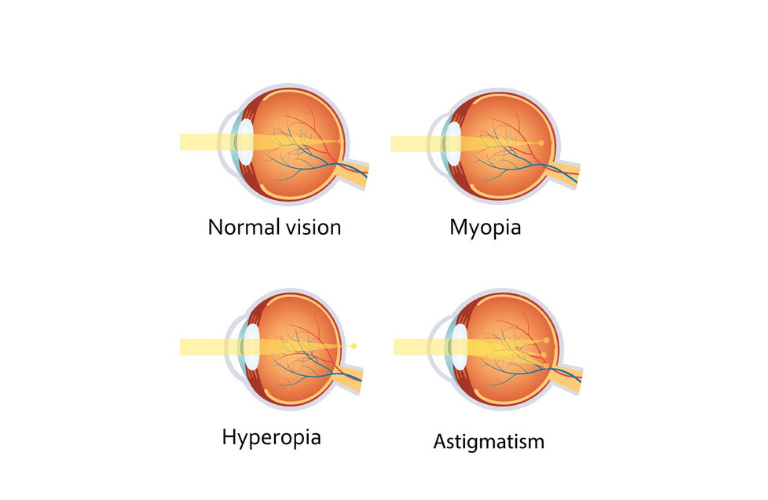
Causes of Vision Impairment
Having discussed various causes of vision impairment previously, let’s now delve deeper into the insights of each cause:
Refractive Errors
Refractive errors are typical eye diseases caused by the shape of the eye, which prevents light from focusing directly on the retina, resulting in blurred vision. Refractive errors are classified into four types:
- Myopia (nearsightedness): It is a problem in which the person is not able to see distant objects clearly, but near objects are very clear to them. That is why it is also known as nearsightedness.
- Hyperopia (farsightedness): It occurs when distant objects may be seen more clearly than nearby objects. Therefore, it is known as farsightedness.
- Astigmatism: This condition causes overall blurry vision, as the cornea or lens is irregularly shaped.
- Presbyopia: It is an age-related eye condition where the eye’s lens loses flexibility due to aging, making it difficult to focus on close objects. The problem occurs between the age of 40-50 years old adults
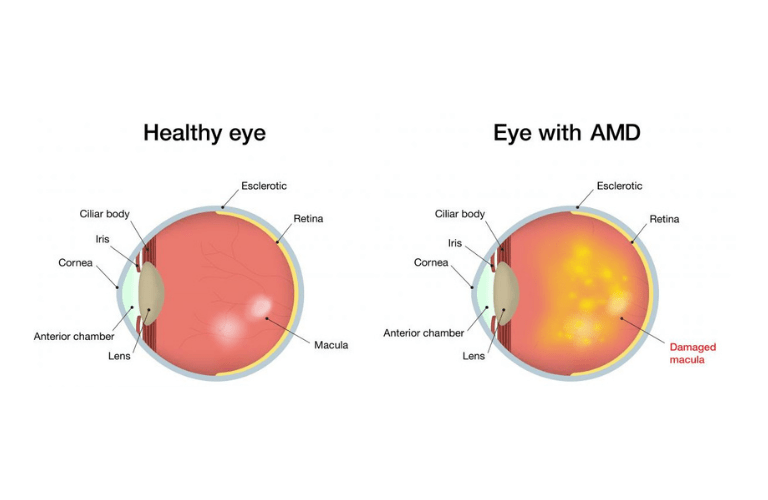
Age-Related Macular Degeneration (AMD)
Macular degeneration is an age-related factor that affects the central part of the eyes. This problem impacts our daily routine as it affects daily activities such as reading, driving, mobile usage, etc. It is of two types:
- Wet AMD: Wet AMD is a condition in which abnormal blood vessels form behind the retina and leak blood and fluid, causing damage and rapid central vision loss. Straight lines becoming wavy is a common early symptom.
- Dry AMD: Dry AMD is characterized by the natural aging process, thinning of the macula, resulting in a gradual blurring of central vision. The appearance of drusen (yellowish deposit under the retina) is one of the first indications of dry AMD. It is the most common form of AMD, accounting for 70-90% of patients, and advances more slowly than the wet variety.
Cataract
A cataract is a common eye disorder that causes clouding of the natural lens of the eye, resulting in vision impairment. Cataract produces hazy vision, difficulties seeing in low light, glare sensitivity, and decreased color perception in the advanced stage. Cataract, in its mature stage, can considerably impede daily activities and may necessitate surgical intervention to restore clear vision.
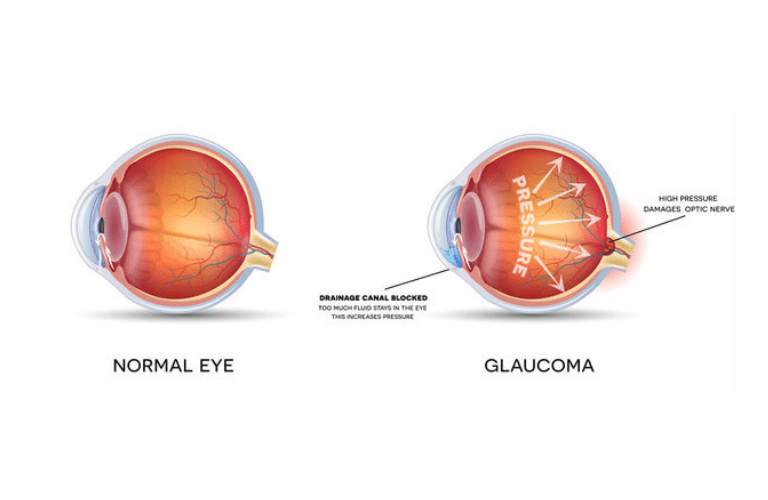
Glaucoma
DIt occurs when the optic nerve is damaged, usually as a result of increasing intraocular pressure. This increasing pressure can progressively cause peripheral vision loss and, if not diagnosed and addressed promptly, can proceed to central vision loss. There are two main types of glaucoma:
- Non-Proliferative Diabetic Retinopathy (NPDR): Blood vessels in the retina weaken and leak, resulting in microaneurysms, hemorrhages, and swelling. If left untreated it can move on to the advanced stage.
- Proliferative Diabetic Retinopathy (NPDR): PDR is a more severe variant in which new, aberrant blood vessels form on the retina’s surface and bleeding occurs. If not treated promptly, these abnormal vessel changes might leak, causing scar tissue to grow and ultimately leading to retinal detachment and significant vision loss.
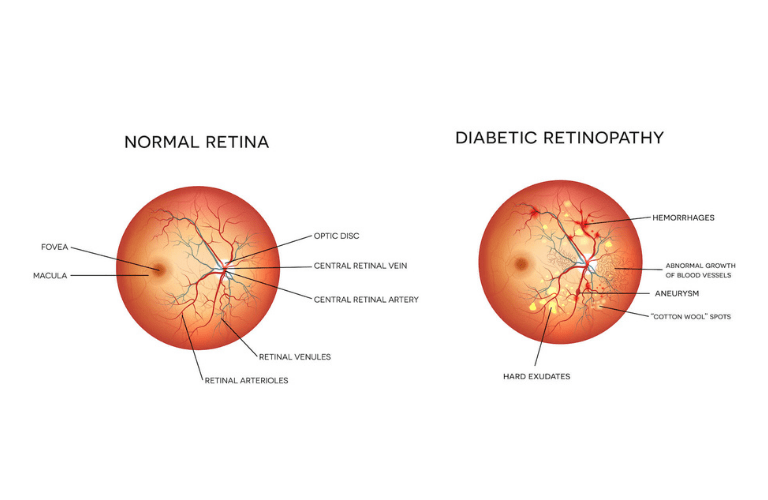
Diabetic Retinopathy
Diabetic retinopathy (DR) is an eye problem that arises as a consequence of diabetes. In this problem, the blood vessels of the retina get severely damaged due to improper blood flow. If neglected for a long time, it can result in complete vision loss. It is of two types:
- Open-angle glaucoma: Open-angle is a chronic ailment that progresses slowly over time without the patient detecting vision loss until its severity.
- Angle-closure glaucoma: It is less common but more severe. It develops when the iris is near the drainage angle, obstructing fluid flow and generating an increase in eye pressure. This necessitates quick medical attention since it can result in quick visual loss which might be permanent.
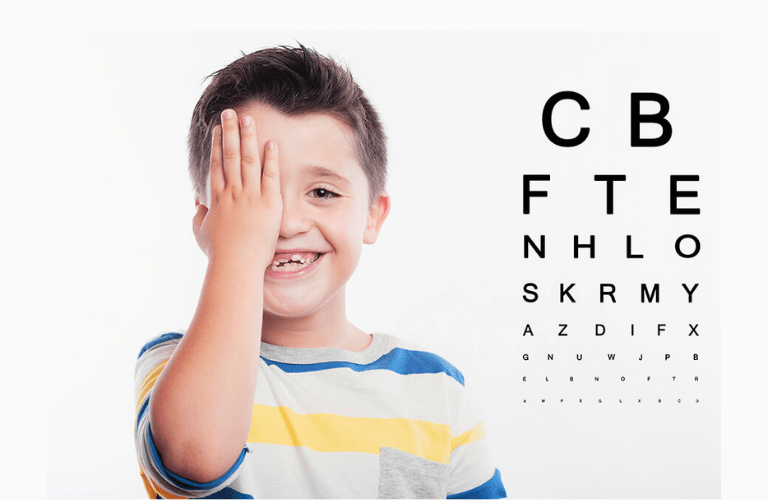
Childhood Vision Problems
Childhood vision problems if left unaddressed or untreated can lead to vision impairment in later life stages. Some of the basic vision problems in children are as follows:
- Refractive errors: Problems such as nearsightedness (myopia), farsightedness (hyperopia), and astigmatism can cause blurry vision and difficulty focusing on objects, affecting a child’s ability to see clearly.
- Amblyopia (lazy eye): Amblyopia is the medical word used when one of the eyes’ vision is impaired because of imperfect coordination between the eye and the brain. In this condition, though the eye appears structurally normal, it is not being utilized normally since the brain favors the other eye. Amblyopia may result from any condition which causes a reduction of vision in one or both eyes in childhood
- Strabismus (crossed eyes): Misalignment of the eyes can lead to double vision and reduced depth perception. It can result in amblyopia if not treated promptly.
- Color vision deficiency: Some children may struggle to differentiate particular colors, which can impair their ability to see and differentiate between different colors.
- Congenital cataract: Cataract present at birth or developing during childhood can cause clouding of the eye’s lens, leading to reduced vision.
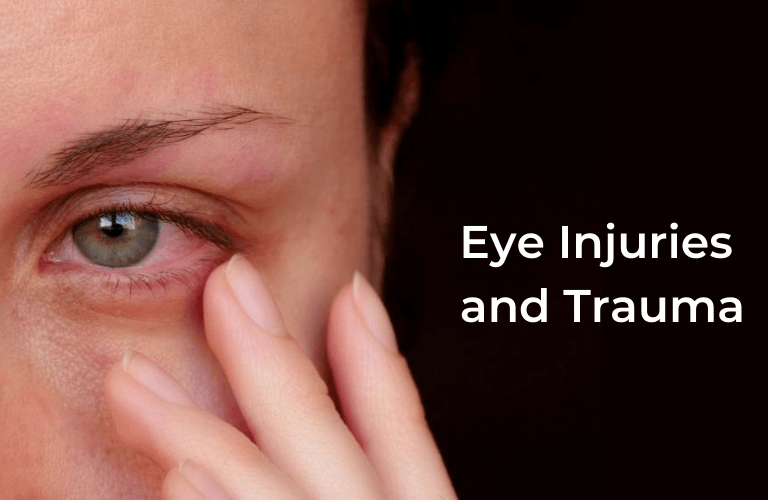
Eye Injuries and Trauma
Eye injuries and trauma both can have a significant impact on vision impairment. The severity depends on the type and location of the eye affected during an eye injury. The common causes of eye injuries include accidents, sports-related incidents, workplace hazards, and assaults. Some of the eye injuries leading to vision impairment are as follows:
- Corneal injuries: The lens of the eye helps focus light into the retina. Trauma to the lens can cause cataract, clouding of the lens, leading to blurry vision and reduced visual acuity.
- Retinal injuries: The retina is an important layer of tissue located at the back of the eye that processes visual information. Retinal injuries, such as detachment or tears, can result in partial or complete vision loss in the affected portion of the eye.
- Optic nerve injuries: The optic nerve is responsible for transmitting visual signals from the retina to the brain. Trauma to the optic nerve can result in lifelong visual loss and can be difficult to repair
- Foreign body injuries: Entry of small particles or things in the eye can scrape the cornea or other eye structures, causing irritation, redness, and reduced vision.
How Can We Prevent Vision Impairment Leading to Blindness
Some of the preventive measures to reduce vision impairment that can lead to blindness are as follows:
-
- : Even if you don’t have any obvious vision difficulties, schedule frequent comprehensive eye examinations with an eye care specialist. The diagnosis of eye problems and disorders at an early stage enables timely intervention and treatment.
- Maintain a Healthy Lifestyle: A balanced diet rich in nutrients such as omega-3 fatty acids, lutein, and zeaxanthin is beneficial for eye health. In addition, avoid smoking, as it increases the risk of age-related eye diseases.
- Manage Chronic Conditions: Regular evaluation of changes in chronic conditions like diabetes and hypertension can help you in maintaining good eye health.
- Eye Protection: Wear protective eyewear, such as safety goggles, when engaging in activities with potential eye injury risks, such as sports, construction work, or household chores involving hazardous materials.
- Limiting Screen Time: Reduce prolonged exposure to digital screens such as mobile, laptops, and TVs. Ensure to take regular breaks to prevent eye strain and discomfort.
- UV Protection: Wear sunglasses that block UV rays to protect your eyes from harmful ultraviolet radiation while going out on a sunny day.
- Maintain Good Hygiene: Wash your hands regularly, especially before touching your eyes or applying contact lenses. Do not rub your eyes, as it can increase infection.
- Know your family history: Be aware of your family history of eye disorders, as some eye conditions get worse if genetically transferred.
Take adequate sleep and drink plenty of water: Getting 6-8 hours of sleep provides adequate rest to your eyes, leaving them refreshed and healthy. Additionally, incorporating an ample amount of water into your daily routine helps prevent dry eyes.
Conclusion:
Understanding the root causes of vision loss is critical to combating this silent pandemic. We can lower its occurrence and ensure a brighter future for those affected by introducing preventive measures, early detection, and quick treatment. Regular eye exams, a healthy lifestyle, and adequate eye rest are critical for maintaining our vision and overall well-being.
FAQs
What causes blindness and vision impairment?
The main causes of blindness and vision impairment are eye diseases such as
Cataract
Refractive errors
Diabetic retinopathy
Glaucoma
Age-related Macular disease
childhood vision problems, eye injuries, and other medical conditions.
What is the definition of the visually impaired in India?
Being legally blind indicates that a person’s best-seeing eye has a corrected vision of
20/200 or 6/60, showing limited vision that cannot be greatly improved even with the use
of prescription glasses.
What are the 3 characteristics of vision impairment?
The three main characteristics of vision impairment are
Unable to focus on or follow objects.
Squint frequently & with excessive rubbing.
Chronic eye redness or sensitivity to light.
What causes color blindness?
Genetic changes that damage the cone cells in the retina, which make it challenging to
accurately perceive some colors, are the main cause of color blindness. It is more
prevalent in men and frequently inherited.

No comments yet.